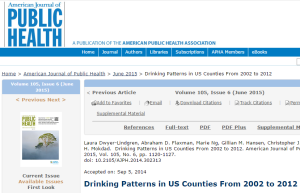 A recent study that appears in the American Journal of Public Health examined rates of alcohol consumption in every county throughout the United States. The study was conducted by researchers at the Institute for Health Metrics and Evaluation at the University of Washington. They found rates for binge drinking and heavy drinking to vary widely through different parts of the country, and observed an increase in binge drinking in recent years.
A recent study that appears in the American Journal of Public Health examined rates of alcohol consumption in every county throughout the United States. The study was conducted by researchers at the Institute for Health Metrics and Evaluation at the University of Washington. They found rates for binge drinking and heavy drinking to vary widely through different parts of the country, and observed an increase in binge drinking in recent years.
There are several health and social implications related to binge drinking, such as the potential for alcohol poisoning, domestic violence, assault, risky sexual behavior, driving under the influence and other behaviors. Interestingly, women are binge drinking at increasing rates. Some experts believe this may be because many women have busier schedules with full-time jobs, taking care of children and other family responsibilities, which combine to create a more stressful environment.
This means that when they do drink they tend to binge during their short windows of times allotted for socialization. “It has a lot to do with perception. It’s acceptable for the PTA mom to go and drink in a bar, it’s not so much with heroin,” commented Dani Kushla, the operator of an alcohol treatment facility.
While men still binge drink more than women overall, it does appear that the gap between the sexes is closing. This surprised researchers, as traditionally women have abused alcohol far less than men. An ongoing problem in the U.S. is the amount of binge drinking that occurs on college campuses. Forming poor alcohol habits at a young age is dangerous because it is more likely that they will continue those habits after they are finished with school as well.
Researchers also included in their report that people who engage in binge drinking are more likely to have blood pressure problems, a lower life expectancy rate, heart disease and liver problems as a result of excessive alcohol consumption.


